German Shepherd Guide
Canis Lupus
Highly active and fearless dogs!
Advertisement
German Shepherd Guide Scientific Classification
- Kingdom
- Animalia
- Phylum
- Chordata
- Class
- Mammalia
- Order
- Carnivora
- Family
- Canidae
- Genus
- Canis
- Scientific Name
- Canis Lupus
Read our Complete Guide to Classification of Animals.
German Shepherd Guide Conservation Status
German Shepherd Guide Facts
German Shepherd Guide as a Pet:
- General Health
- Energy Level
- Shedability
- Trainability
- Intelligence
- Tendency to Chew
- Size
- Family and kid friendliness
- Yappiness / Barking
- Moderate
- Separation Anxiety
- High
- Preferred Temperature
- Average climate
- Exercise Needs
- High
- Friendly With Other Dogs
- Moderate
- Pure bred cost to own
- $500-$1,500
- Dog group
- Working
- Male weight
- 66-88 lbs
- Female weight
- 49-71 lbs
This post may contain affiliate links to our partners like Chewy, Amazon, and others. Purchasing through these helps us further the A-Z Animals mission to educate about the world's species.
View all of the German Shepherd Guide images!
The German shepherd, or Alsatian, as British dog lovers call them, is the second most popular dog breed in the United States.
This working dog from the herding group features a luxurious double coat that can be anywhere from medium to long and comes in a variety of colors such as traditional black and tan, solid white, or solid black. Their exceptional intelligence and adaptability make them well-suited for a wide array of jobs, including police work, service training, and, of course, loving companion.
See all of our expert product reviews.
This breed gets a bad reputation for aggressive behavior, but in reality, these dogs are more aloof with strangers than aggressive. As with any other breed, reputable breeders and early and consistent training determine the dog’s personality. These dogs can alter their personalities to fit their owner and training, so it’s up to the owner to show them how they should behave.
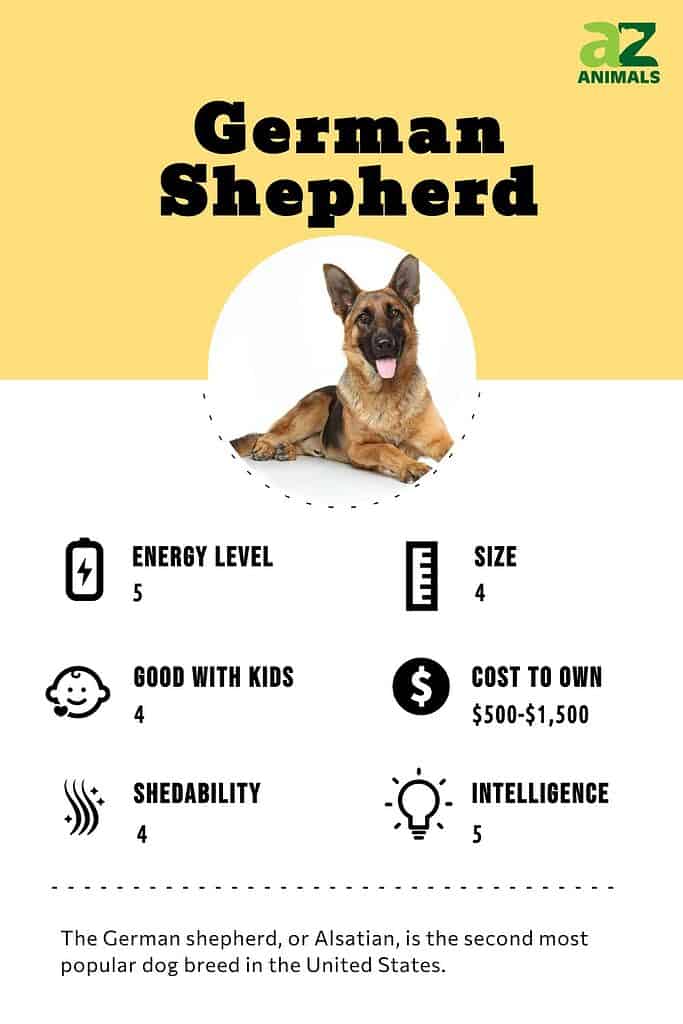
The Different Types of German Shepherd and German Shepherd Mixes
There are quite a few German Shepherd crossbreeds, including:
- Bernese Shepherd – German shepherds are big dogs. Bernese mountain dogs are even larger. Cross these two canine lines, and the result is the Bernese shepherd, a gentle giant of a dog who is intelligent, calm, and extremely good-natured. This hybrid dog is sometimes referred to as the Euro mountain sheparnese. It’s recognized by the American Canine Hybrid Club, the Designer Breed Registry, the Designer Dogs Kennel Club, and the Dog Registry of America.
- Saint Shepherd – Saint Shepherd is a hybrid dog and is a crossbreed between Saint Bernard and the German Shepherd. Both the parent dogs are rather large, making the Saint Shepherd an incredible breed. When they are full-grown, these dogs weigh approximately 120 pounds and stand tall at approximately 28 inches.
- Gerberian Shepsky – With fluffy fur, bright eyes, and incredibly alert senses, the Gerberian Shepsky is one of the most majestic designer dog breeds on the market. These gorgeous and loyal dogs are made by mixing a German Shepherd with a Siberian Husky in the hopes of getting the best traits from both breeds. The result is a dog that’s hardworking, obedient, energetic, and always excited to be part of the action.
- Golden Shepherd – The Golden Shepherd is an eclectic mix between a Golden Retriever and a German Shepherd. Both breeds have a fascinating history. The Golden Retriever was originally bred in the Scottish Highlands as an exuberant gundog that would find and retrieve game. The German Shepherd descended from large German herding dogs in the 19th century. Its incredible combination of intelligence, athleticism and speed has served all kinds of purposes, from police work to search and rescue. It was also used in both world wars.
- Alaskan Shepherd – The Alaskan Shepherd is a hybrid crossbreed dog that blends together two hefty breeds: the Alaskan Malamute and the German Shepherd. The Alaskan Malamute is a big, intelligent working breed, originally bred as a sled dog in the Arctic, with a confident, dignified demeanor and a loyal bearing. It descended from the wolf dogs that came across the Bering Strait thousands of years ago. The German Shepherd is another intelligent working dog that now serves as a police dog, service dog, and general companion in the home.
- Shepkita – Also known as the Akita Shepherd, Shepkita is a hybrid dog. It is a crossbreed between the Akita and the German Shepherd, giving them a loyal and stoic nature. They are also extremely hard-working. Shepkita puppies often end up inheriting some of the best traits from both their parents.
- German Sheppit – The German Sheppit is a first-generation hybrid between two different breeds of dogs: a German Shepherd and a Pit Bull. German Shepherds are big herding dogs that excel at many different tasks, including police work, search and rescue, and home protection. The Pit Bull, by contrast, is a group of several different breeds, including the American Pit Bull Terrier, the American Staffordshire Terrier, and the Bull Terrier, all united by a muscular, short-haired appearance.
- Chow Shepherd – The Chow Shepherd, also known as a Sheprachow, is a cross between two very different dog breeds: the Chow Chow and the German Shepherd. The Chow Chow is an intelligent and dignified all-purpose dog that originated from ancient China and became a favorite of the country’s nobility. As a member of the spitz group, it has long, thick fur and a pointed muzzle and ears. The German Shepherd, by contrast, is a large and intelligent herding dog with a long history of police work and service.
- Beagle Shepherd – The Beagle Shepherd is another hybrid breed that has emerged from the recent frenzy of designer dog creation. As is typical of such efforts, the originator of the breed is not fully known or acknowledged. The Beagle Shepherd is an enthusiastic and clever dog that can be trained to do the most amazing circus-like tricks. This is often very surprising to find in a larger dog.
- Shepweiler – If you’re looking for a loyal and protective working or guard dog, then you can do no worse than the Shepweiler. This uncommon hybrid is produced from the crossing of two different breeds: the Rottweiler and the German Shepherd. The Rottweiler is a strong and muscular working breed that descended from the ancient Mastiffs. Over the centuries, it has been used to herd livestock, guard homes, and do police and rescue work. The German Shepherd is a muscular and agile herding dog that first arose in the 19th century to wrangle sheep. It became an excellent watchdog, police dog, and overall service dog.
- Shollie – Shollies are a hybrid, or designer, dog breed. They are a mix between a German Shepherd and a Border Collie. These dogs are energetic, devoted, and loyal. They are a large dog breed that sheds quite a bit and requires a large amount of exercise. In return, they will be loving companions and are a great choice for families with children. Shollies are one of the newest popular mix breeds.
- Corman Shepherd – The Corman Shepherd puppies are known to inherit the best qualities from both parents, and they go by several names, like the German Corgi or the Corgi German Shepherd. You could adopt these hybrid dogs from adoption centers and rescue shelters, but you can also seek out a known breeder. The lifespan of these dogs is about 10 to 15 years.
3 Pros and Cons of Ownership
| Pros! | Cons! |
| They are beautiful dogs. German shepherds are well known for their thick, luxurious coats and come in a variety of attractive colors like black and tan, solid black, and solid white. | They have an aggressive reputation. Though their reputation isn’t accurate, many people see this breed as aggressive. Due to this misconception, your dog may not be welcome in dog parks, and new friends may be hesitant to visit your home. Your homeowner’s insurance premium could be higher than average as well. |
| They have a long lifespan. German shepherds live for about 10 to 14 years, which means you’ll get to enjoy time with your canine companion for years to come. | They shed excessively. Throughout most of the year, a German shepherd’s hair is manageable when you brush them multiple times a week, but during the two times they shed their coats each year, you’ll need to brush them at least once each day to keep ahead of the shedding. |
| They are highly intelligent and easy to train. Unlike most intelligent breeds, German shepherds are eager to please their masters, which makes training them a joy. This trait is what makes them highly skilled working dogs in both service fields and police training. | They can be destructive if they don’t get enough attention. German shepherds thoroughly attach themselves to their families, so if you leave them home alone for long periods, they will develop separation anxiety. This anxiety can lead to extremely destructive behavior that will not only destroy your home but can cause health issues in your pup as well. |
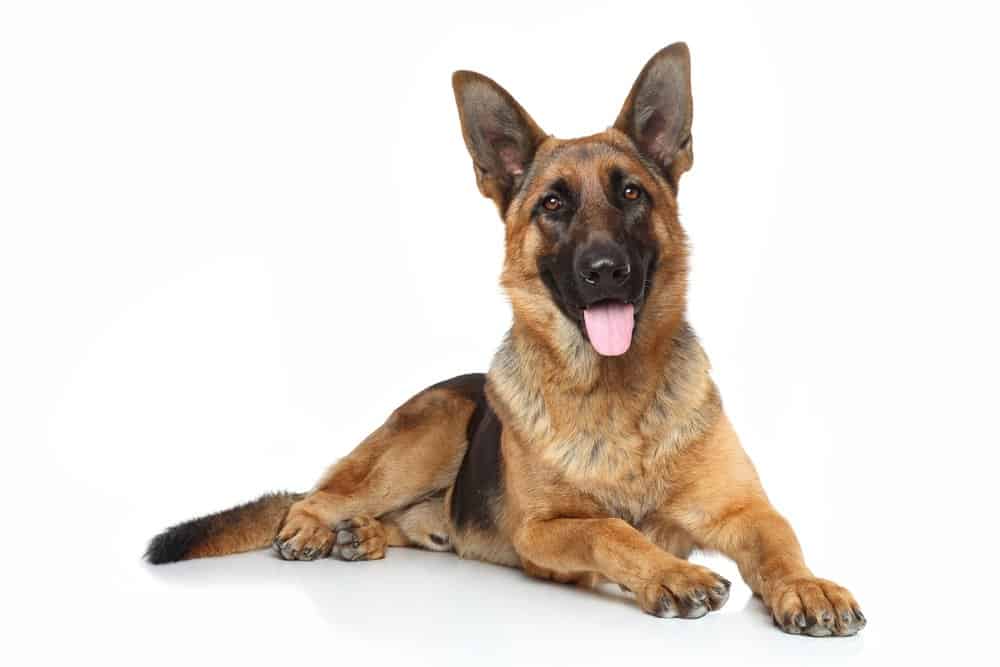
German shepherds are well known for their thick, luxurious coats and come in a variety of attractive colors like black and tan, solid black, and solid white.
©Jagodka/Shutterstock.com
Size and Weight
On average, German shepherds weigh between 75 and 90 pounds and stand 22 to 26 inches high at the shoulder. The males of this breed tend to be larger than the females.
Health and Entertainment for your German Shepherd Guide
See all of our expert product reviews.
Common Health Issues
Like many purebred dogs, German shepherds are prone to some fairly serious health conditions. One such condition, degenerative myelopathy, is a neurological disease that targets the spinal cord. It tends to come on later in life and leads to reduced mobility.
Bloating is another life-threatening concern for this breed, so owners should establish proper eating routines from an early age. Owners can reduce the occurrence of bloating by feeding smaller meals throughout the day, using a dish that forces a dog to eat slowly, using an elevated feeder, and preventing heavy exercise for up to two hours after each meal.
This breed can also develop other serious conditions such as:
- Epilepsy
- Hip or elbow dysplasia
- von Willebrand’s Disease
- Thyroid disorders
- Skin allergies
- Lupus
- Progressive retinal atrophy
- Perianal fistulas
- Pannus
- Pancreatic enzyme inefficiency
- Panosteitis
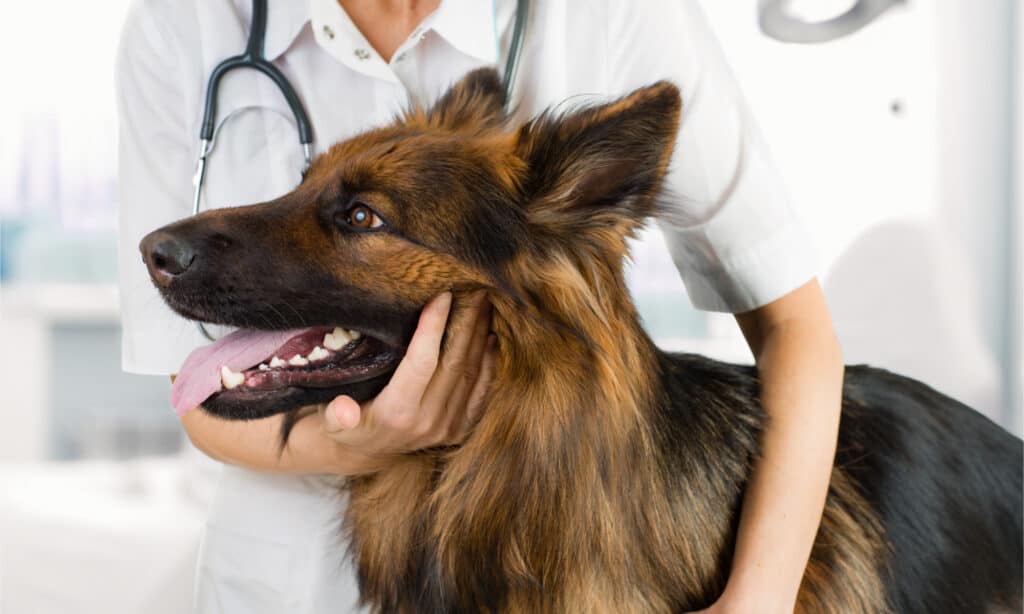
Like many purebred dogs, German shepherds are prone to some fairly serious health conditions.
©Andrey_Kuzmin/Shutterstock.com
Temperament
This breed has a certain level of dignity that many other breeds don’t possess, which means you’ll have to work for their friendship. Though it may take them longer to bond and make new friends than other dogs, once that friendship is forged, they make extremely loyal companions.
These dogs are one of the most intelligent dog breeds, which makes them excel at any job their owner chooses. They are also quite sensitive and hate being left alone, so if you spend much of your time away from home and can’t take your dog with you, a German shepherd is not the right dog for you.
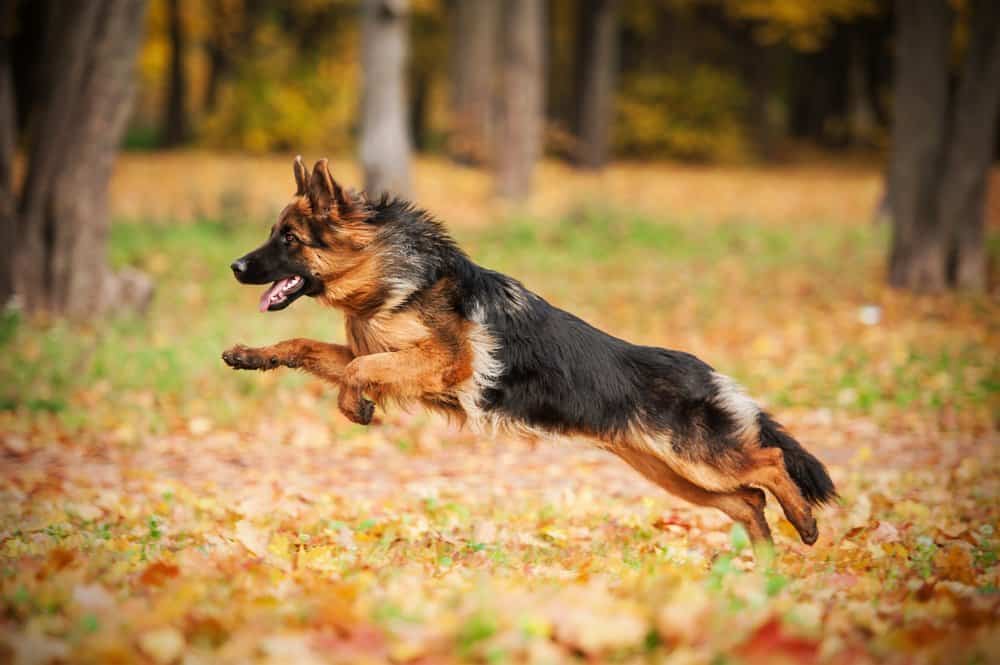
Though it may take them longer to bond and make new friends than other dogs, once that friendship is forged, they make extremely loyal companions.
©Rita_Kochmarjova/Shutterstock.com
Aggression
Another myth is that German shepherds aren’t good with kids. On the contrary, their high energy, extreme trainability, and loyalty are all excellent traits for family pets. Due to their adult size and strength, early training and socialization around children are imperative to prevent injuries. It is also vital that parents teach their children how to interact with dogs safely.
Contrary to popular belief, these dogs are not naturally aggressive dogs. One of the biggest myths about this breed is that even if they begin life as docile animals, they will develop aggression. Many times, the public bases its opinion of this breed on dogs that work in jobs that require selective aggressive tendencies, like the kind that is common in police dogs. Training is the most important factor in determining aggression in any dog. Since German shepherds are so adaptable and eager to please, owners can teach them calm behavior just as easily as aggressive behavior. That’s not to say a well-trained German shepherd will never become aggressive; any dog who feels threatened may display aggressive behaviors to defend itself.
Along these lines, German shepherds also have a bad and unfairly earned reputation for biting. This reputation is another behavior that some owners train in their dogs, leaving all German shepherds with a bad rap. In reality, labrador retrievers account for more bites on a yearly basis than German shepherds do. For most dogs, biting occurs when they are afraid, so proper training and socialization are imperative to keep your dog from displaying behaviors that could be deemed aggressive.

Training is the most important factor in determining aggression in any dog, and since German shepherds are so adaptable and eager to please, owners can teach them calm behavior just as easily as aggressive behavior.
©iStock.com/Milan Krasula
Origin and History
The origins of the German Shepherd date back to just before the turn of the 20th century. They, of course, came from Germany but did not look like they do today until after World War II, after many years of breed solidification. These early shepherds were developed by a cavalry officer named Max von Stephanitz after he retired from the military. He worked with country sheep dogs to produce an extreme working dog that would be able to herd all day and run for long stretches of the day. The first versions had short tails and rough fur coats.
As mentioned, in the United Kingdom, German shepherds are sometimes referred to as “Alsatians”, which draws some confusion. Many of this breed were often found in the Alsace area of France, which was once a region of Germany. Moreover, due to the two world wars, avoiding using “German” in the name may have been a marketing choice to help make the breed more popular.
How To Take Care of One
If you want the best dog food for your german shepherd first you need to consider whether your dog is still a puppy, an adult, or a senior dog. Smaller breeds mature to adulthood in about 10 months, a little under a year. While larger breeds, like German Shepherds, typically mature at 16 months, or about a year and a half. Most breeds are considered a senior at 10 years, though some very large breeds (100lb+) hit that milestone a little earlier around year 8.
Based on the size, coat length, and specific health considerations for german shepherds our team recommends the following:
- Best dog food for German Shepherd puppies.
- Best dog food for German Shepherd adults.
- Best dog food for German Shepherd seniors.
- Best dog food for German Shepherd dogs with allergies.
German shepherds do well on high-quality food formulated especially for large breeds. These dogs tend to have somewhat sensitive stomachs, so they should only eat human food sparingly, if at all. If you do choose to feed your dog table scraps, you should avoid fatty foods and never feed them cooked bones. When dogs eat cooked bones, the bones break into splintery shards that can perforate their stomach or bowels on their way through the digestive system.

German shepherds tend to have somewhat sensitive stomachs.
©Aleksandra Dabrowa/Shutterstock.com
The Best Dog Food for Them
There are many health problems that can plague German Shepherds, so owners have to try their best to find a dog food that has the correct nutritional profile to keep them up and moving.
At A-Z Animals, we’ve taken a look at Royal Canin Breed Health Nutrition German Shepherd Loaf in Sauce Wet Dog Food, and we think it could be a good option for your German Shepherd.
First and foremost, this food has glucosamine, calcium, and chondroitin for hips and elbows that hold up under German Shepherds’ frame and keep them mobile. The pork and chicken provide lots of high-quality protein for lean muscle, with other vital nutrients like riboflavin, thiamine, and vitamins.
Check Chewy or Amazon for this product.
- Rich in fiber
- Supports muscle and joint health
- Boosts immunity and muscle and brain growth
- Especially formulated for German Shepherds
Best Insurance
Like any other purebred dog, you’ll need to find pet insurance that covers the hereditary genetic disorders associated with a German shepherd.
Maintenance And Grooming
All German shepherds have a thick double coat consisting of a soft, dense undercoat and a coarse, water-resistant topcoat that is medium to long. Their coat is easy to maintain most of the year by brushing them every few days. Twice a year, they go through a major shedding spree called blowing, a month-long process in which they lose their seasonal undercoat. During the blowing season, you will need to brush your dog daily to avoid matting and hair build-up around the house.
Aside from brushing, the maintenance routine for a German shepherd is straightforward. All you need to do is brush their teeth regularly and trim their nails monthly. This breed is fairly clean with only a slight odor, so they only need bathing a few times a year.
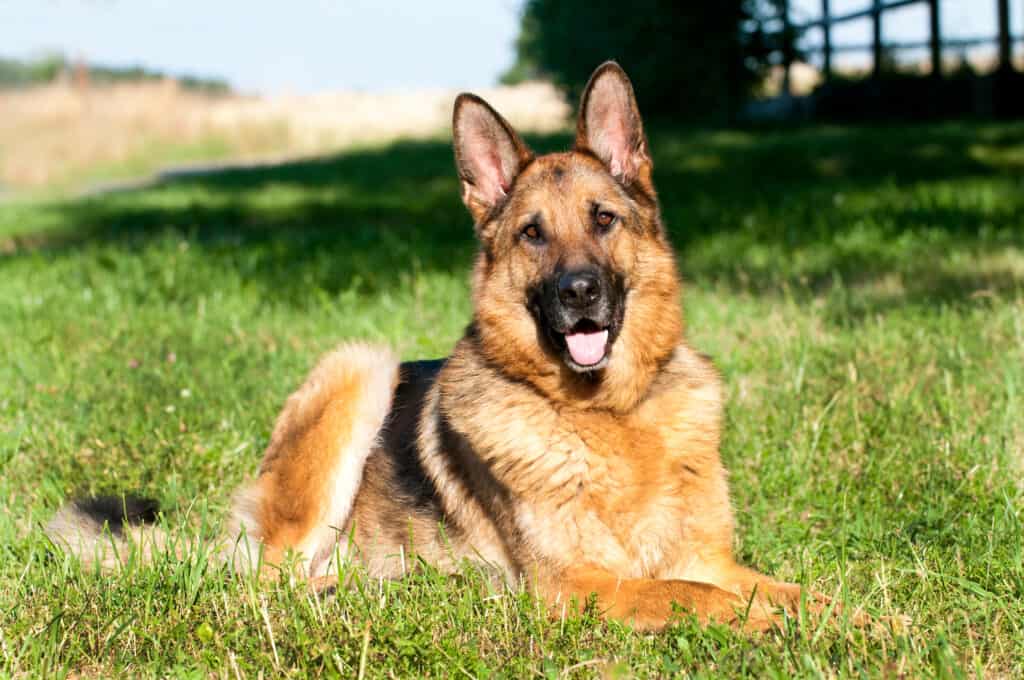
A German shepherd’s coat is easy to maintain most of the year by brushing it every few days.
©Dora Zett/Shutterstock.com
Training
Unlike many intelligent breeds, German shepherds are eager to please their owners, which makes them a joy to train. All herding dogs have a certain level of protectiveness toward their families, so proper training and socialization should start immediately to show them that not every stranger means them harm.
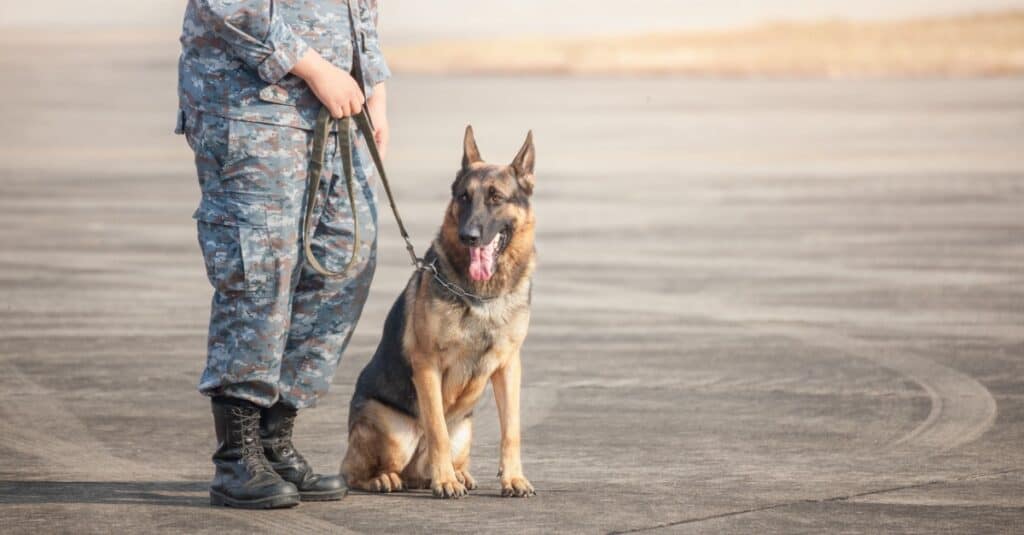
German Shepherds were bred to be the ultimate working dog.
©iStock.com/Puttachat Kumkrong
Exercise
German shepherds are an active breed and require copious amounts of exercise to keep them happy and healthy. Since these dogs are highly intelligent, their exercise choices need not end at walks or backyard play. Dogs and owners alike can enjoy intellectual and agility-based activities like tracking and herding to create an unbreakable bond between them.
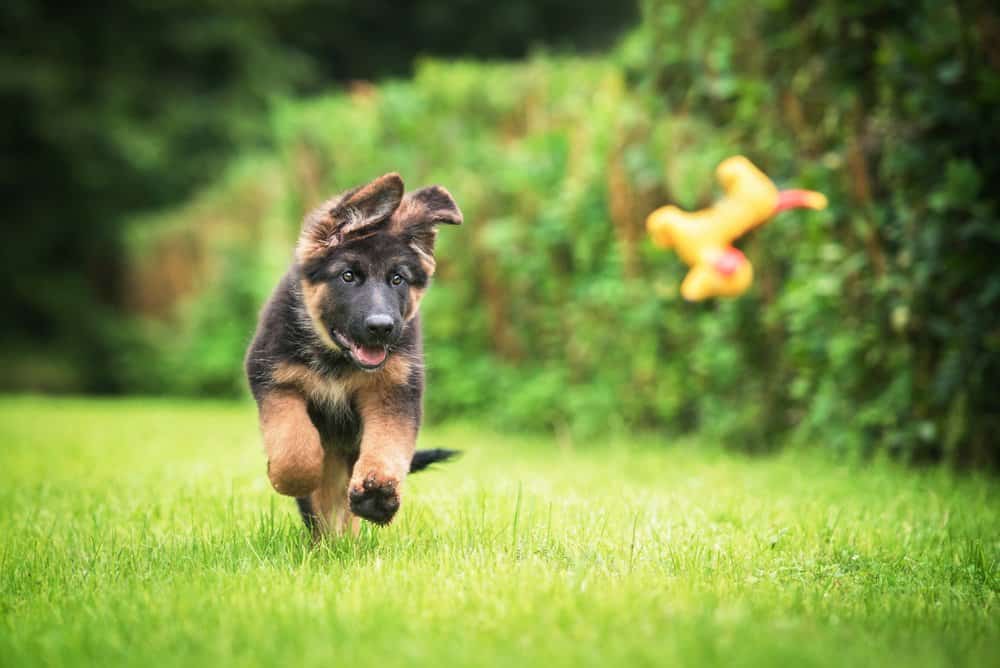
German shepherds are an active breed and require copious amounts of exercise to keep them happy and healthy.
©Rita_Kochmarjova/Shutterstock.com
Puppies
As with all puppies, weeks 7 to 12 are the most crucial when it comes to proper socialization for German shepherds. If you want your dog to get along well with children or other pets, this is the optimal window to have them accept other members of their new family without many questions. That’s not to say you can’t teach your dog to get along with kids and other animals down the road, but the more exposure you can give your pup to all types of situations when they are young, the more likely you will be to have a calm, well-adjusted adult dog.
German shepherds don’t become adults until they are about 3 years old, so remember to be patient with your dog even when he looks like he’s outgrown his puppyhood.
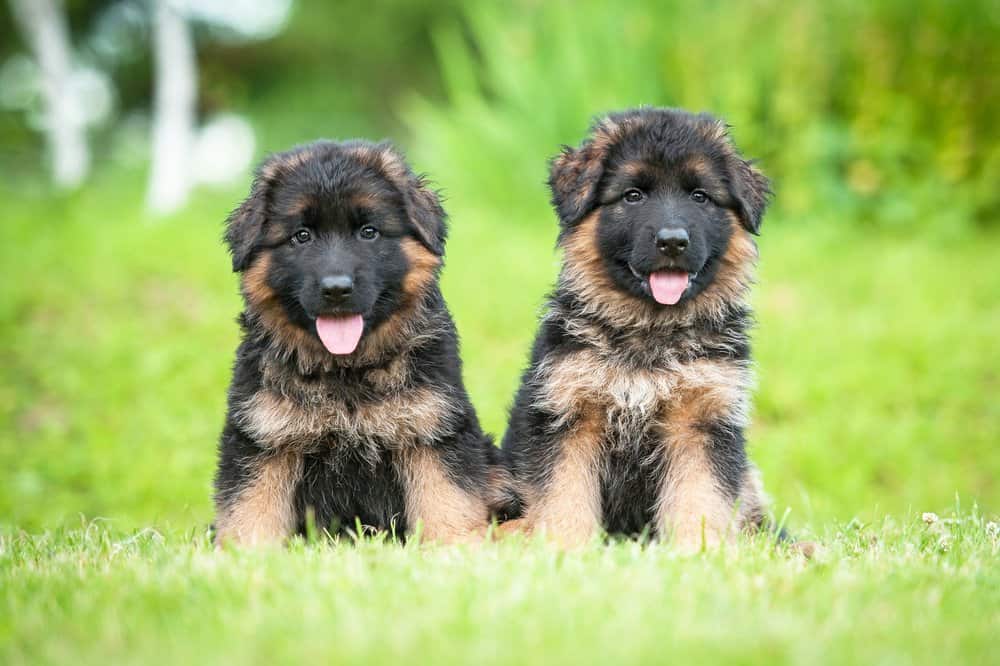
As with all puppies, weeks 7 to 12 are the most crucial when it comes to proper socialization for German shepherds.
©Rita_Kochmarjova/Shutterstock.com
With Children
If you raise your German shepherd with children from the start, they get along famously with all members of the family. That said, they are high-energy dogs who don’t always realize how big they are. Owners should take time to teach both dog and child how to safely interact with one another and never leave them unsupervised to avoid accidental injuries.
It is in the nature of a German shepherd to be aloof towards strangers, however, and children are no exception. It is vital for any owner who plans to have their dog around unfamiliar children to socialize them extensively and train them for this task at a young age. At the same time, parents should take care to teach their children the proper way to approach any unknown dog.

Owners should take time to teach both dog and child how to safely interact with one another and never leave them unsupervised to avoid accidental injuries.
©Stone36/Shutterstock.com
Similar Dogs
A few breeds that are similar in size or personality to German shepherds are Australian shepherds, Collies and Old English sheepdogs.
- Australian shepherd: Australian shepherds have the same loyal and intelligent personality as a German Shepherd but in a smaller package.
- Collie: Collies are roughly the same size as German shepherds and have the same devotion to their families, but they have a slightly longer lifespan. Check out our comparison for German Shepherds and Border Collies here!
- Old English sheepdog: Old English sheepdogs are adaptable and intelligent like German shepherds, but they don’t need as much exercise.
Famous Examples
Though there have been quite a number of famous German shepherds throughout history, the one who brought his breed into the spotlight was Rin-Tin-Tin. Corporal Lee Duncan found Rin-Tin-Tin and his littermates during World War 1 in the small French village of Flirey. Duncan raised the pup as his own and taught him an expansive collection of tricks. Rin-Tin-Tin’s impressive intelligence ultimately landed him a number of movie deals. Over the course of his illustrious career, he often played the part of a wolf because movie directors found him much easier to work with than an actual wolf. This famous pup was the original key to the success of the Warner Brothers film company.
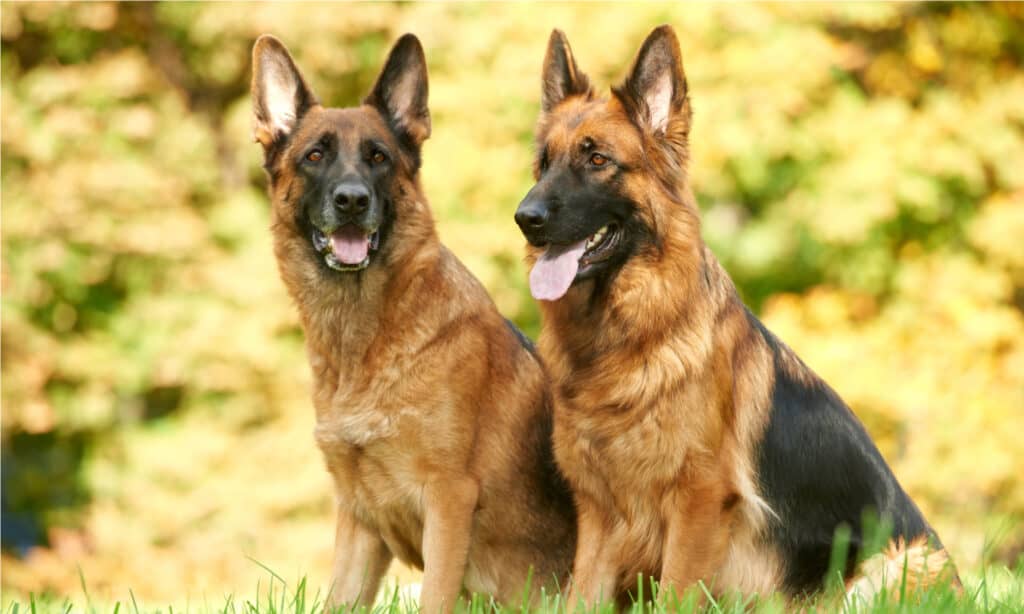
There have been quite a number of famous German shepherds throughout history.
©Dmitry Kalinovsky/Shutterstock.com
Popular Names for Them
A few popular names for these dogs are:
- Ruger
- Bandit
- Ace
- Tucker
- Diesel
- Maggie
- Daisy
- Harley
- Sasha
- Lady
German Shepherd Guide FAQs (Frequently Asked Questions)
What is the scientific name for a German shepherd?
The scientific name for a German shepherd is Canis lupus familiaris. This breed is also known among British dog lovers as the Alsatian.
How long do German Shepherds live?
German shepherds live for an average of 10 to 14 years.
Are German shepherds aggressive?
Despite pop culture giving them a bad reputation for aggressive behavior, most German Shepherds are more aloof than aggressive. As with any breed, care in breeding, training and socialization is what determines a dog’s behavior.
Do German shepherds make good family dogs?
German Shepherds are loyal, intelligent and eager to please, which makes them excellent family dogs.
How big do German shepherds get?
German Shepherds often weigh between 75 and 90 pounds and stand 22 to 26 inches high at the shoulder. Males are usually bigger than females.
Are Shiloh shepherds and German shepherds the same breed?
No. While Shiloh shepherds and German shepherds look similar and have similar temperaments, they are different breeds. The main difference between them is that German shepherds are purebreds, while Shiloh shepherds are a mixed breed with Alaskan Malamute and German shepherd roots.
Are German Shepherds herbivores, carnivores, or omnivores?
German Shepherds are Omnivores, meaning they eat both plants and other animals.
What Kingdom do German Shepherds belong to?
German Shepherds belong to the Kingdom Animalia.
What class do German Shepherds belong to?
German Shepherds belong to the class Mammalia.
What phylum to German Shepherds belong to?
German Shepherds belong to the phylum Chordata.
What family do German Shepherds belong to?
German Shepherds belong to the family Canidae.
What order do German Shepherds belong to?
German Shepherds belong to the order Carnivora.
What type of covering do German Shepherds have?
German Shepherds are covered in Hair.
What genus do German Shepherds belong to?
German Shepherds belong to the genus Canis.
What is an interesting fact about German Shepherds?
German Shepherds are highly active and fearless dogs!
What's the difference between German shepherds and king shepherds?
German shepherds are purebred dogs while king shepherds are not. King shepherds are also larger dogs overall.
What's the difference between German Shepherds and Rottweilers?
There are a few key differences between Rottweilers and German Shepherds, namely that Rottweilers grow far larger than German shepherds on average. German Shepherds also have thicker fur compared to the short fur of the Rottweiler.
What's the difference between German Shepherds and Australian Shepherds?
There are many differences between German Shepherds and Australian Shepherds. Australian Shepherds come in more colors and markings than German Shepherds, while German Shepherds grow larger than Australian Shepherds on average.
What's the difference between German Shepherds and golden retrievers?
German Shepherds grow larger than golden retrievers, and they were bred for different purposes. Golden retrievers also have floppy ears, while German Shepherds have pointed ears.
What's the difference between German Shepherds and Norwegian Elkhounds?
German Shepherds are larger than Norwegian Elkhounds, and they also have longer ears and noses. Additionally, Norwegian Elkhounds are an ancient dog breed from Europe, while the German Shepherd originated in Germany during the 1800s.
Which is a better guard dog: Doberman Vs German Shepherd?
The Doberman is the better guard dog due to its size, trainability and adaptability, and temperament.
The Doberman and the German Shepherd are both versatile breeds able to adapt to nearly any situation and anyone with enough training and socialization.
What's the difference between the German Shepherd and the Belgian Shepherd?
The German Shepherd is larger than the Belgian Shepherd, while the Belgian Shepherd is more friendly compared to the aloof German Shepherd. Additionally, these breeds originated in different locations, despite being bred for the same type of work.
What's the difference between the German Shepherd and the Belgian Tervuren?
The German Shepherd is larger than the Belgian Tervuren, while the Tervuren has a slightly longer lifespan. Both of these dogs were bred as herding breeds, though the German Shepherd works in police more than the Belgian Tervuren.
What's the difference between the German Shepherd and the Akita?
The Akita grows larger than the German Shepherd, though their sizes often overlap. In addition, the Akita was originally bred for hunting, while the German Shepherd was originally bred for herding.
What's the difference between German Shepherds and Dutch Shepherds??
The main differences between a German and Dutch Shepherd are their size, coat, lifespan, popularity, country of origin, and price. German Shepherds are larger with shorter lifespans, a wide variety of coat colors, and immense popularity, which leads to most breeders charging less for puppies.
What are the key differences between Catahoula Leopard Dogs and German Shepherds?
The key differences between Catahoula Leopard Dogs and German Shepherds are appearance, coat, temperament, health issues, exercise, and training.
What are the key differences between Beauceron and German Shepherd?
The key difference between a Beauceron and a German Shepherd is temperament. Shepherds tend to be more affectionate and easy to train, while Beaucerons are more independent.
Other important differences include size, appearance, lifespan, trainability, energy level, grooming needs, and drooling level.
What are the differences between German Shepherds and Kangals?
The major difference between German Shepherds and Kangal Shepherds is size. Other key differences include appearance, lifespan, and barking level.
Thank you for reading! Have some feedback for us? Contact the AZ Animals editorial team.
















